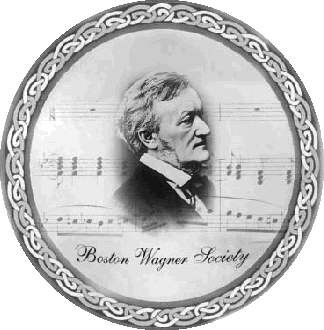Icelandic Sagas of the Ring Cycle
The Society's second lecture program, on April 23 at the Union Club, featured Dr. Árni Björnsson, who had just arrived from Reykjavik on a tour to promote his new book [Wagner and the Volsungs: Icelandic Sources of DER RING DES NIBELUNGEN, by Árni Björnsson, published by the Viking Society for Northern Research, University College, London, ISBN 0 903521 55 5; see the review in the April–May issue of Wagneriana] on the Icelandic sources of Wagner's Ring. A noted scholar, lecturer in Icelandic language and literature, and past director of the Folklore Department of the National Museum of Iceland, Björnsson was a genial, soft-spoken, but energetic scholar whose profile bore a startling mirror-image resemblance to Richard Wagner's own on the cover of his book as enlarged by the slide projector.
Björnsson's thesis is that the sources for Wagner's Ring are overwhelmingly Icelandic (the Sagas)—as part of a larger Scandinavian culture—rather than Germanic: 80 percent of the plot elements are purely Icelandic, 15 percent are common to both Icelandic and Germanic sources, and only 5 percent are purely Germanic—from the Nibelunglied or Jacob Grimm—and used only in Götterdämmerung. In the course of an absorbing hour, Björnsson discussed the arrival of the sagas in early-19th-century Germany, which was still reeling from its defeat at the hands of Napoleon and thirsting for some sense of cultural identity, in particular heroic figures from the past. He documented two critical points in the Ring's development when exposure to newly published Icelandic material reinvigorated Wagner, propelling the vast project forward after periods of neglect.
During a lively question-and-answer session following the talk, Society members showed an interest in the working of the oral tradition. Björnsson expanded on Jacob Grimm's discovery that German myth had its origins in India and Persia and the uniqueness in Icelandic myth of a ring of fire on a mountaintop.
His book, which was for sale during the evening with the author available for signing, has many interesting features, perhaps the most valuable being an extensive section that comprises more than half of the book, in which passages from the Ring in the original German and in English translation are compared directly with equivalent passages from the Sagas in Icelandic and English. There are numerous illustrations, everything from manuscripts and book-title pages to cartoons of Wagner and his operas, lithographs and photos of the original Ring production, relevant artwork from various periods, and photographs of Wagner and his circle. The book begins with a concise but informative grounding in Icelandic, Scandinavian, and Viking cultures, as well as a brief biography and chronology of the composer.
A Short Bibliography
The Sagas make for fascinating reading; they are about the myth and religion of the Scandinavian peoples and their history and include stories of individual settlers in Iceland and Greenland. The written versions of the Sagas date mostly from the 13th century, composed in Icelandic rather than Latin and filled with vivid details of the life of that time. The modern English translations come with the maps, notes, chronologies, glossaries, and genealogies necessary to fully understand the scope and importance of these unique voices from the past. You can find them with a search on “amazon.com”: target “books,” type “Icelandic Sagas” in the search box, and click on “GO” button. All are available in paperback editions, and most can be ordered as good used copies for a price reasonable enough to encourage collecting several of them.
Sagas basic to Wagner's Ring
The Poetic Edda, translated by Carolyne Larrington, Oxford World's Classics, ISBN 0192839462;
The Prose Edda, by Snorri Sturluson, translated by Jean I. Young, University of California Press, ISBN 0520234774;
Volsunga Saga, translated by Jesse L. Byock. Migration Period and Viking-age myths and legends of Sigurd, Attila, Valkyries, Odin, and more. Penguin Classics, ISBN 0140447385.
Others that influenced the Ring
Thidrek's Saga, Gisla Saga, Heimskringla, Egil's Saga.
Sagas on Nordic history and the settlement of Greenland and Iceland
The Saga of King Hrolf Kraki, translated by Jesse L. Byock, contains embedded within it a recognizable version of Beowulf. Penguin Classics, ISBN 0140435934.
Eyrbyggja Saga, translated by Palson and Edwards. Icelandic life and the coming of Christianity to Iceland. Penguin Classics, ISBN 0140445307.
Njal's Saga, Laxdaela Saga, Eirik the Red's Saga, and several others.
– William Fregosi
